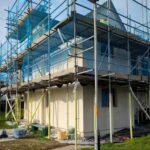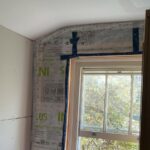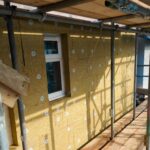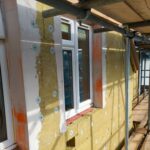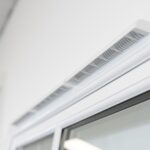In Cavity Wall Insulation, CWI, EWI, External Wall Insulation, Internal Wall Insulation, IWI, Retrofit by Robert Wheeler / 14 February 2024 / 0 comments

Retrofit insulation refers to the process of adding insulation to existing buildings in order to improve energy efficiency, reduce utility bills, and enhance overall comfort. As energy costs continue to rise and environmental concerns become more prominent, retrofit insulation has emerged as a viable solution for homeowners and property owners looking to upgrade their buildings. By insulating walls, roofs, floors, and other areas, retrofit insulation helps to minimize heat loss or gain, resulting in reduced energy consumption and a smaller carbon footprint.
This blog post explores the concept of retrofit insulation, its benefits, cost considerations, various insulation materials, the process involved, energy savings, potential challenges, and recommendations for those considering retrofitting insulation in their buildings.
Introduction to Retrofit Insulation
What is Retrofit Insulation?
Retrofit insulation is like giving your home a cozy sweater to keep it warm and energy-efficient. It involves adding insulation to existing buildings that may not have sufficient insulation or have insulation that has deteriorated over time. Think of it as a much-needed upgrade for your home’s thermal performance.
Importance of Retrofitting Existing Buildings
Retrofitting existing buildings with insulation is crucial for a number of reasons. First and foremost, it helps to improve energy efficiency, reducing the amount of energy needed to heat or cool your home. This not only saves you money on utility bills but also reduces your carbon footprint.
Additionally, retrofit insulation enhances comfort by keeping temperature fluctuations at bay and improving indoor air quality. It can also increase the value of your property, making it an investment that pays off in the long run.
Benefits of Retrofit Insulation
Improved Energy Efficiency and Reduced Utility Bills
One of the major perks of retrofit insulation is its ability to significantly improve energy efficiency. By preventing heat loss in the winter and heat gain in the summer, it helps reduce the need for excessive heating and cooling, resulting in lower utility bills. Who doesn’t love the sound of saving money while staying comfortable?
Enhanced Comfort and Indoor Air Quality
Imagine feeling cozy and snug in your home, no matter what the weather is like outside. Retrofit insulation can make that dream a reality. It helps create a more stable indoor temperature, reducing drafts and eliminating cold spots, making your living space more comfortable. Plus, it acts as a barrier against outdoor noise and contributes to better indoor air quality by minimizing the infiltration of dust, pollen, and other allergens.
Increased Property Value
Investing in retrofit insulation not only improves your home’s energy efficiency and comfort, but it can also boost its value. Potential buyers appreciate a well-insulated home that will save them money on energy bills in the long run. So, if you plan to sell your house in the future, retrofit insulation can be a smart selling point that sets your property apart from the competition.
Cost Considerations for Retrofit Insulation
Initial Investment and Return on Investment (ROI)
Now, let’s talk about the elephant in the room: money. Retrofit insulation does come with an initial investment, but fear not, it’s often worth it in the long run. The money you save on energy bills can help recoup the costs over time, and you’ll enjoy the benefits of a more comfortable home in the meantime. It’s like hitting two birds with one stone – or, in this case, saving money while staying cozy.
Financing Options for Retrofit Insulation
If the upfront cost is a concern, there are various financing options available to make retrofit insulation more accessible. Some utility companies offer rebates and incentives for energy-efficient upgrades, and there are even government programs and low-interest loans specifically designed to support energy-saving improvements. So, don’t let the initial cost scare you away from the long-term benefits!
Types of Retrofit Insulation Materials
Fiberglass Insulation
Fiberglass insulation is like the classic choice for retrofit insulation. It’s made of finely woven glass fibers that trap air pockets, creating a barrier against heat transfer. It’s easy to install, cost-effective, and has been a staple in insulation for decades. Plus, it doesn’t release any harmful chemicals or toxins into your home, which is always a plus.
Cellulose Insulation
If you’re looking for an eco-friendly option, cellulose insulation is a great choice. It’s typically made from recycled paper, which is treated to be fire-resistant and resistant to pests. Cellulose insulation is effective at reducing heat flow and can be blown into wall cavities or added as loose fill in attics. It’s a sustainable and efficient way to give your home an insulation boost.
Spray Foam Insulation
For those seeking a more high-tech solution, spray foam insulation offers impressive performance. It’s a liquid that expands and hardens into a solid foam, sealing gaps and providing an airtight barrier. Spray foam insulation is excellent for hard-to-reach areas and can provide superior insulation compared to other materials. Just be sure to hire a professional for the installation, as it requires specialized equipment and expertise.
So, if you’ve been wondering whether retrofit insulation is worth it, the answer is a resounding yes! It improves energy efficiency, boosts comfort, adds value to your home, and, let’s not forget, saves you some serious cash. With various insulation materials and financing options available, it’s easier than ever to give your home that much-needed upgrade. Time to cozy up and enjoy the benefits!
The Process of Retrofitting Insulation
Insulation Assessment and Planning
First things first, before you embark on the journey of retrofitting insulation, you’ll want to assess your current insulation situation. Take a look at your walls, ceilings, and floors to determine what kind of insulation you currently have (if any) and what areas could benefit from an upgrade.
Once you’ve assessed your insulation needs, it’s time to plan. Consider factors like your budget, the type of insulation that would work best for your home, and any specific areas that require attention. You may also want to consult with a professional to get expert advice and ensure you’re making the right choices.
Preparing the Building for Retrofit Insulation
Before you can dive into the world of retrofit insulation, some preparation work is necessary. This includes clearing any clutter or obstacles that could impede the installation process. You’ll also want to inspect your building for any potential issues, such as leaks or structural problems, that could affect the effectiveness of the insulation.
Cleaning and repairing any existing damage beforehand will help ensure a smooth and successful insulation installation. This is also a great time to seal any air leaks to maximize the energy efficiency of your home.
Installation Techniques and Considerations
When it comes to retrofit insulation, there are a variety of installation techniques to choose from. The right method for your home will depend on factors like the type of insulation you’re using and the specific areas you’re targeting.
Whether you’re going the DIY route or hiring a professional, it’s important to follow proper installation techniques to ensure the insulation is effective. This includes proper sealing and avoiding compression, as these can diminish the insulation’s performance.
Energy Savings and Environmental Impact of Retrofit Insulation
Quantifying the Energy Savings
One of the biggest draws of retrofit insulation is the potential for energy savings. By improving your home’s insulation, you can reduce heat loss during the winter and keep cool air in during the summer. This translates to lower energy bills and a more comfortable living environment.
While the actual energy savings will vary depending on factors like your climate and existing insulation levels, studies have shown that retrofit insulation can lead to significant reductions in energy consumption. So, not only will you be saving money, but you’ll also be doing your part in reducing greenhouse gas emissions.
Environmental Benefits and Reduction of Carbon Footprint
Speaking of greenhouse gas emissions, retrofit insulation also has a positive impact on the environment. By reducing your energy consumption, you’re effectively lowering your carbon footprint.
When you retrofit your home with insulation, you’re making a small but important contribution to combating climate change. And hey, saving the planet is always a nice bonus!
Potential Challenges and Limitations of Retrofit Insulation
Accessibility and Structural Limitations
While retrofit insulation can work wonders, it’s not without its challenges. Depending on your home’s construction, some areas may be difficult to access. This can make insulation installation more tricky or even impossible in certain spots.
Structural limitations can also play a role. Some buildings may have design features or materials that make retrofit insulation less effective or even unsuitable. It’s important to consider these factors before diving into a retrofit insulation project.
Moisture and Ventilation Considerations
Moisture management and ventilation are essential considerations when it comes to retrofit insulation. While insulation helps keep the heat in and the cold out, it can also trap moisture if not properly addressed.
Proper ventilation is crucial to prevent moisture-related issues such as mold growth. It’s important to ensure that the retrofit insulation project doesn’t hinder the natural airflow and ventilation within your home.
Compatibility with Existing Building Systems
Compatibility is another factor to consider. When retrofitting insulation, it’s important to make sure that the insulation materials and installation techniques are compatible with your existing building systems.
Certain insulation materials may not play well with others or could cause issues with your electrical or HVAC systems. To avoid complications, consult with professionals who can guide you on the best choices for your specific building systems.
Conclusion and Recommendations for Retrofit Insulation
In conclusion, retrofit insulation offers numerous benefits, including improved energy efficiency, enhanced comfort, and increased property value. While there are costs to consider, the long-term savings and environmental impact make it a worthwhile investment. It is crucial to assess the specific needs of your building and choose the appropriate insulation materials and techniques. By consulting with professionals and conducting thorough planning, you can ensure a successful retrofit insulation project. Embracing retrofit insulation not only contributes to a more sustainable future but also provides immediate benefits for homeowners and property owners alike. Start exploring the possibilities of retrofit insulation and take a step towards a more energy-efficient and comfortable living or working environment.
FAQs: Retrofit Insulation
Retrofit insulation can be a worthwhile investment due to its potential for long-term energy savings, increased comfort, and enhanced property value. However, the cost-effectiveness depends on various factors such as the building’s condition, insulation materials chosen, and local energy costs. A thorough evaluation of the specific situation is recommended before making a decision.
Retrofit insulation can typically be installed in most types of buildings, including residential homes, commercial properties, and even historic structures. However, certain architectural or structural limitations may exist, requiring customized solutions or alternative methods. Consultation with insulation professionals and building experts is crucial to determine the feasibility and potential challenges specific to your building.
The energy savings achieved through retrofit insulation varies depending on factors like the insulation materials used, the extent of the insulation installation, and the climate in which the building is located. On average, retrofit insulation can lead to significant reductions in heating and cooling costs, typically ranging from 10% to 40%, depending on the building’s insulation needs and the quality of the installation.
In many regions, there are government incentives, tax credits, or financial assistance programs available to encourage energy-efficient upgrades, including retrofit insulation. These programs may vary widely depending on your location, so it is advisable to research local initiatives or consult with energy efficiency organizations to explore potential financial assistance options.
Ready to discuss your regeneration project and how NXTGEN Futures Ltd can elevate it with expert retrofit? Contact us today!
Latest Retrofit Posts
- What a retrofit-first approach offers the UKRetrofitting is like giving your home a makeover to make it more energy-efficient, comfortable, and healthy. The retrofit-first approach prioritizes upgrading existing buildings over new construction to tackle climate change and improve living conditions. Definition of Retrofitting Retrofitting involves making… Read more: What a retrofit-first approach offers the UK
- What is internal wall insulation?Internal wall insulation is a crucial component of creating a comfortable and energy-efficient living space. By insulating the walls within a building, homeowners can experience benefits such as improved thermal performance, reduced energy bills, and enhanced acoustic comfort. Understanding the… Read more: What is internal wall insulation?
- What is a retrofit assessor?Retrofit assessors play a crucial role in the sustainability and energy efficiency of buildings by evaluating and identifying opportunities for improvement. This blog post aims to provide an in-depth understanding of the responsibilities, qualifications, and benefits associated with being a… Read more: What is a retrofit assessor?
- What is a retrofit assessment in the UK?Retrofit assessments play a crucial role in the sustainable development of buildings in the UK, helping to improve energy efficiency, reduce carbon emissions, and enhance overall building performance. By evaluating existing structures and identifying opportunities for upgrades and enhancements, retrofit… Read more: What is a retrofit assessment in the UK?
- Retrofit and Energy Efficiency in Historic BuildingsHistoric buildings are not only architectural treasures but also valuable cultural assets that contribute to our sense of history and identity. However, many of these buildings often suffer from poor energy efficiency, leading to excessive energy consumption and high operating… Read more: Retrofit and Energy Efficiency in Historic Buildings
- What is retrofitting in construction?Retrofitting in construction is a crucial process that involves upgrading existing buildings or structures to meet modern standards of safety, energy efficiency, and functionality. This blog post explores the concept of retrofitting, its importance, various techniques used in the industry,… Read more: What is retrofitting in construction?
- CASE STUDY: Curtis WayDelivering a Holistic Retrofit Solution with EWI & Solar Energy Project Overview NXTGEN Futures Ltd. successfully completed a large-scale retrofit project on Curtis Way, Berkhamsted, England, UK. This case study showcases our expertise in External Wall Insulation (EWI), retrofit coordination,… Read more: CASE STUDY: Curtis Way
- What happens to a building during retrofitting?Building retrofitting is a vital process that involves making significant modifications and improvements to existing structures to enhance their efficiency, functionality, and sustainability. In this blog post, we will delve into the intricate workings of building retrofitting, exploring the various… Read more: What happens to a building during retrofitting?
- UK Government Retrofit Scheme: Making Energy Efficiency Cool AgainIntroduction to the UK Government Retrofit Scheme Background of the Retrofit Scheme Picture this: you’re sitting at home, snuggled up in your favourite blanket, enjoying a cup of tea, when suddenly you feel a draft. Not cool, right? Well, that’s… Read more: UK Government Retrofit Scheme: Making Energy Efficiency Cool Again
- What are Retrofit Trickle Vents?Improving indoor air quality and enhancing energy efficiency are key priorities for many homeowners. In this article, we will explore the concept of retrofit trickle vents and their role in achieving these goals. Trickle vents are small, adjustable openings integrated… Read more: What are Retrofit Trickle Vents?
- Retrofit Underfloor HeatingRetrofit underfloor heating has gained significant popularity as a cost-effective and efficient solution for enhancing the comfort and energy efficiency of existing buildings. Unlike traditional radiator systems, underfloor heating distributes warmth evenly across the floor, providing a comfortable and cozy… Read more: Retrofit Underfloor Heating
- Retrofit LondonRetrofitting has emerged as a crucial solution in transforming the landscape of cities, and London is no exception. As a global hub of culture, commerce, and innovation, London faces the pressing challenge of reducing its carbon footprint while ensuring sustainable… Read more: Retrofit London

